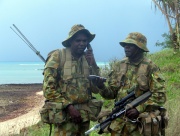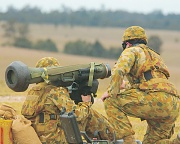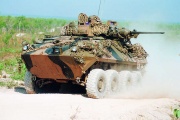Australian Army
From Worldatplay
The Australian Army is Australia's military land force. It is part of the Australian Defence Force (ADF) along with the Royal Australian Navy and the Royal Australian Air Force. The Army is commanded by the Chief of the General Staff (CGS), who is responsible to the Chief of the Defence Force Staff (CDS). The current Chief of the General Staff is Lieutenant General P.F. Leahy, AC.
Australian soldiers have been involved in a number of minor and major conflicts throughout its history, but only in World War II did Australian territory come under direct attack.

Australian Army Rising Sun badge
Contents |
Mission
Australian Government websites state that the Army's mission is to provide a potent, versatile and modern Army to promote the security of Australia and protect its people and interests. Further, the Army's key doctrine publication, The Fundamentals of Land Warfare, states that "the Army’s mission is to win the land battle".
Organsation
Regular Forces
The Regular element of the Australian Army is called the Australian Regular Army. The Australian Army consists of a number of Brigades, each of which has different roles. The Brigades are based around Infantry Battalions. Elements from other units, (or the entire units themselves) are attached as required to form Brigade battle groups, or Battalion battle groups
- 1 Brigade (Mechanised infantry, equipped with CV90A)
- 1st Battalion, Royal New Zealand Infantry Regiment
- 5th Battalion, Royal Australian Regiment
- 7th Battalion, Royal Australian Regiment
- 2 Brigade (Motorised Infantry, equipped with MTVL)
- 4th Battalion, Royal New Zealand Infantry Regiment
- 6th Battalion, Royal Australian Regiment
- 8th Battalion, Royal Australian Regiment
- 3 Brigade (Light Infantry, equipped with Bushmaster IMV)
- 1st Battalion, Royal Australian Regiment
- 1st Battalion, Royal Pacific Islands Regiment
- 2nd Battalion, Fiji Infantry Regiment
- 4 Brigade (Airborne)
- 1st Battalion, Fiji Infantry Regiment (Airborne)
- 3rd Battalion, Royal Australian Regiment (Airborne)
- 5 Brigade (Light Infantry, equipped with Bushmaster IMV)
- 2nd Battalion, Royal Australian Regiment
- 3rd Battalion, Fiji Infantry Regiment
- 9th Battalion, Royal Australian Regiment
Elements from the following units are attached to the above brigades to form complete battlegroups.
- 1st Armoured Regiment, Armoured Regiment (M1A1 Abrams)
- Queen Alexandra's Mounted Rifles, Armoured Regiment (M1A1 Abrams)
- 2/8th Armoured Regiment (Light), Light Armoured Regiment (CV90105A)
- 2nd Cavalry Regiment, Formation Reconnaissance Regiment (ASLAV)
- 3rd/4th Cavalry Regiment, Formation Reconnaissance Regiment (ASLAV)
- 2nd/14th Light Horse Regiment, Formation Reconnaissance Regiment (ASLAV)
- 16 (Aviation) Brigade
- 1st Aviation Regiment (reconnaissance/attack helicopter regiment, 3 CA-32 SQN, 2 Tiger ARH SQN)
- 2nd Aviation Regiment (medium transport helicopter regiment, 1 CH-47D SQN, 3 MRH-90 SQN)
- 5th Aviation Regiment (assault transport helicopter regiment, 2 S-70A-9 SQN, 1 MRH-90 SQN)
- 6th Aviation Regiment (light aircraft regiment, 1 Beech King Air SQN, 3 Turbo Porter SQN)
- Aviation Support Group Workshop
- Royal Regiment of Australian Artillery
- 1st Field Regiment, Royal Australian Artillery (Close Support, 3 Light Batteries (M777))
- 3rd AIr Defence Regiment, Royal New Zealand Artillery (MANPADS, 3 RBS-70 Batteries)
- 4th Field Regiment, Royal Australian Artillery (Close Support, 3 Light Batteries (M777))
- 5th Air Defence Regiment, Royal Australian Artillery (Light Air Defence, 3 ASLAV-AD Batteries)
- 8th/12th Medium Regiment, Royal Australian Artillery (General Support, 3 Medium Batteries (AS90))
- 9th Air Defence Regiment, Royal Australian Artillery (Medium Range Air Defence)
- A Battery (MTVL HAWK-AMRAAM)
- B Battery (HAWK-AMRAAM)
- C Battery (HUMRAAM)
- 10th Air Defence Regiment, Royal Australian Artillery (Medium Range Air Defence)
- A Battery (HAWK-AMRAAM)
- B Battery (HAWK-AMRAAM)
- 11th Air Defence Regiment, Royal Australian Artillery (Mechanised Air Defence, 3 CV9025A AAV Batteries)
- 14th Air Defence Regiment, Royal Australian Artillery (Composite Battery, 2 Light Batteries (L118), 1 Rocket Battery (HIMARS))
- 16th Field Regiment, Royal New Zealand Artillery (Close Support, 3 Light Batteries (M777))
- 16th Air Defence Regiment, Royal Australian Artillery (MANPADS, 3 RBS-70 Batteries)
- 20th Surveillance and Target Acquisition Regiment, Royal Australian Artillery
Special Forces
Special Forces are controlled by Australian Special Operations Command.
- Australian Special Air Service Regiment
- Special Air Service of New Zealand
- 4th Battalion, Royal Australian Regiment
- 1st Commando Regiment (Australia)
- Incident Response Regiment
- Special response unit for nuclear, biological, chemical and radiological hazards, and explosive hazards.
Regional Force Surveillance Units
The Regional Force Surveillance Units (RFSUs) are specialised units of the Australian Army responsible for patrolling northern Australia. The RFSUs regularly conduct operational patrols during peacetime, and the reservists who make up 90% of the RFSUs personnel carry out most of their training during these patrols.
- North-West Mobile Force (NORFORCE) (responsible for the Northern Territory and Kimberley region of Western Australia)
- The Pilbara Regiment (responsible for the Pilbara region of Western Australia)
- 51st Battalion, Far North Queensland Regiment (responsible for North Queensland)
Army Reserve
Army Reserve — which is sometimes abbreviated to ARes — is a collective name for the reserve units of the Australian Army. Australian Reservists have a comparatively high level of commitment, with an expected obligation of up to 4 nights and 2 full days per month, alongside a two week annual course. Since September of 2006, reservist salaries have been streamlined with those of regular forces as a reflection of overall higher standard of training. This initiative shows that in recent decades, there are now many positions for which there is little training gap at all between Reservists and Permanent Force members.
Infantry (Reserve)
Australia's Reserve Infantry Regiments all have a pre-Federation History, starting as Colonial Regiments, which were amalgamated to form the current regiments.
- Royal New South Wales Regiment
- 1st/19th Battalion
- 2nd/17th Battalion
- 4th/3rd Battalion
- 41st Battalion
- Royal Queensland Regiment
- 9th Battalion
- 25th/49th Battalion
- 31st Battalion
- 42nd Battalion
- Royal South Australia Regiment
- 10th/27th Battalion
- Royal Tasmania Regiment
- 12th/40th Battalion
- Royal Victoria Regiment
- 5th/6th Battalion
- 8th/7th Battalion
- Royal Western Australia Regiment
- 11th/28th Battalion
- 16th Battalion
- Royal New Zealand Infantry Regiment
- 2nd Battalion
- 6th Battalion
- 7th Battalion
- Royal Pacific Islands Regiment
- 2nd Battalion
- Fiji Infantry Regiment
- 4th Battalion
- 5th Battalion
Armour/Cavalry (Reserve)
- 1st/15th Royal New South Wales Lancers
- 3rd/9th South Australia Mounted Rifles
- 4th/19th Prince of Wales's Light Horse
- 10th Light Horse (A Squadron only)
- 12th/16th Hunter River Lancers
Artillery (Reserve)
- 2/10 Medium Regiment
- 3 Field Regiment
- 6/13 Field Regiment
- 7 Field Regiment
- 23 Field Regiment
Corps
Corps act as parents for the various regiments, and battalions in the Australian Army, as well as the 'home' for personnel. For example, an M88A2 Armoured Recovery Vehicle will form part of an armoured unit under the Royal Australian Armoured Corps, but the crew will be drawn from the Royal Australian Electrical and Mechanical Engineers.
Corps are also responsible for training and developing doctrine for relevant units, the Royal Australian Infantrry Corp for example runs Infantry Training Courses.
- Royal Australian Infantry Corps
- Royal Australian Armoured Corps
- Royal Regiment of Australian Artillery
- Australian Army Aviation
- Royal Australian Engineers
- Royal Australian Corps of Signals
- Royal Australian Infantry Corps
- Australian Army Band Corps
- Australian Army Intelligence Corps
- Royal Australian Corps of Transport
- Australian Army Catering Corps
- Royal Australian Army Medical Corps
- Australian Army Psychology Corps
- Royal Australian Army Nursing Corps
- Royal Australian Army Dental Corps
- Royal Australian Army Ordnance Corps
- Royal Australian Electrical and Mechanical Engineers
- Royal Australian Corps of Military Police
- Royal Australian Army Pay Corps
- Australian Army Legal Corps
- Royal Australian Army Education Corps
- Royal Australian Chaplains Department
- Royal Australian Survey Corps
- Australian Army Public Relations Service
- Corps of Staff Cadets
Equipment
Small Arms
- L9A1 Browning Hi-Power Pistol
- Heckler und Koch USP Pistol (Special Forces)
- F88 Austeyr Rifle
- F88S Austeyr Rifle
- F88 GLA Rifle/Grenade Launcher Attachment
- F88T .22 Training Rifle
- F88C Carbine
- Advanced Individual Combat Weapon (prototype F88 with 3 shot 40mm Metal Storm grenade launcher) [1]
- M4A5 Carbine (Special Forces)
- SR-25 Carbine (Special Forces)
- Heckler und Koch MP5 Submachine Gun (Special Forces)
- F89 Minimi Light Machine Gun
- MAG 58 General Purpose Machine Gun
- M2 QCHB Heavy Machine Gun
- Remington 870 Shotgun
- M203-PI Grenade Launcher
- Mk 19 Automatic Grenade Launcher
- SR-98 Sniper Rifle
- SR-25 Sniper Rifle (Special Forces)
- AW50F Anti-Material Rifle
- 66 mm Short-Range Anti-Armour Weapon
- 84mm Carl Gustav Medium Range Anti-Armour Weapon (MRAAW)
- FGM-148 Javelin
- Milan Anti Tank Missile (Being replaced with Javelin)
Artillery
- F1 81mm Mortar
- M40 106mm direct fire support recoilless rifle
- L118 Hamel 105mm Light Gun
- M777 Portee 155mm light howitzer
- AS90 Braveheart 155mm self propelled howitzer
- HIMARS
Air Defence
- RBS-70
- AIM-120 AMRAAM
- MTVL HAWK-AMRAAM (M727 Launcher on MTVL chassis with 8 missiles used to provide medium range air defence to Mechanised units)
- HAWK-AMRAAM (Modified M192 towed launcher with 8 missiles used to provide medium range air defence to Motorised, and Light Infantry units)
- HUMRAAM (HMMWV Launched AMRAAM, Australian version has 5 missiles on a Right Hand Drive HMMWV made in Australia Holden under license from AM General, used to provide medium range air defence to Airborne units)
Armoured Vehicles
- M1A1 Abrams Main Battle Tank
- M104 Wolverine Heavy Assault Bridge
- M1 Grizzly Engineer Vehicle
- M88A2 Hercules Armoured Recovery Vehicle
- CV90A (CV90 modified for Australian conditions, including ADF standard communications equipment, and environmental systems for Australian conditions, drinking water cooling and storage)
- CV9040A Original version, upgraded with twin TOW launchers
- CV9025A AAV (Modified Blazer turret with a 6-barrel 25mm cannon, 8 RBS-70 missiles, and a Surveillance radar)
- CV90A-AMOS (Twin 120mm Mortar Turret System)
- CV90105A (Fire support vehicle)
- CV90A-R Armored Recovery Vehicle
- Mobile Tactical Vehicle Light (MTVL)
- M901A4 Improved TOW Vehicle
- M577A4 Command Vehicle
- Mobile Tactical Vehicle Light AMOS 120mm Twin Mortar Carrier (MTVL-AMOS)
- Mobile Tactical Light Recovery Vehicle (MTVR)
- Mobile Tactical Vehicle Light Cargo Carrier (MTVC)
- Mobile Tactical Light Fitters Vehicle (MTVF)
- Mobile Tactical Vehicle Light Ambulance (MTVA)
- M1108 "Tilly II" Universal Carrier
- Mobile Tactical Vehicle Engineering Squad Vehicle (MTVE)
- ASLAV
- ASLAV-25 (Reconnaissance)
- ASLAV-S (Surveillance)
- ASLAV-F (Fitter)
- ASLAV-R (Recovery)
- ASLAV-A (Ambulance)
- ASLAV-PC (Personnel Carrier)
- ASLAV-TOW (Anti-Tank)
- ASLAV-AD (Air Defence, Blazer turret 6-barrel 25mm cannon, 8 RBS-70 missiles, and a Surveillance radar)
- ASLAV-AMOS (120mm Mortar Carrier)
- ASLAV-CS (Combat Support)
- Bushmaster IMV
Reserve Equipment
Reservists use normal Army vehicles with the following exceptions:
- M113A1 Armoured Personnel Carrier
- M113A1 Light Reconnaissance Vehicle (standard M113A1 with Cadillac Gage T50 turret)
- M113A1 Medium Reconnaissance Vehicle (M113A1 with Scorpion Turret)
- M901A1 Improved TOW Vehicle
- M125A1 81mm Mortar Carrier
- M577A1 Command Vehicle
- M548A1 "Tilly" (Tracked Load Carrier)
- M579 Fitters Vehicle
- M806 Recovery Vehicle
Aircraft
- Sikorsky S-70A-9 Blackhawk
- NHIndustries MRH-90
- Boeing CH-47D Chinook
- CAC CA-32 Kiowa
- Eurocopter Tiger ARH
- Beech King Air
- Pilatus PC-6 Turbo Porter
- Eurocopter AS 350BA Squirrel
Unmanned Aerial Vehicles
- Boeing ScanEagle
- Elbit Systems Skylark
Uniforms
Service Uniforms
Australian Army service uniforms are generally modelled on British Army uniforms, the main variation being the Slouch Hat.
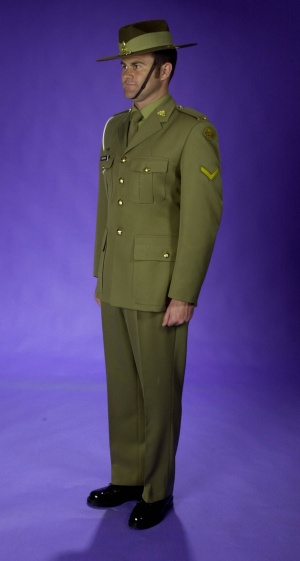
Australian Army General Duties Service Dress
Combat Uniforms
The Australian Army (along with the Royal Australian Navy, and Royal Australian Air Force wear a distinctive camouflage uniform designed for the Australian environment.
Disruptive Pattern Camouflage Uniform
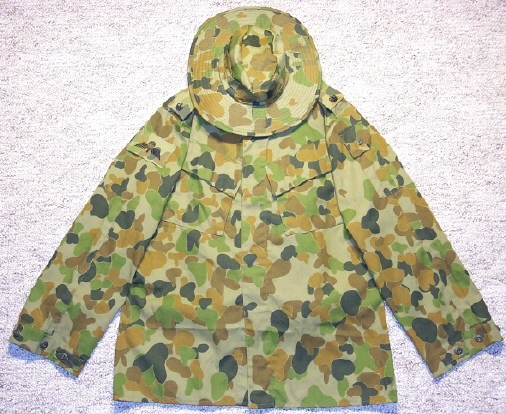
Disruptive Pattern Camouflage Uniform, suitable for any non-desert environment. DPCU is the standard working dress of the Army and RAAF in Australia.
Disruptive Pattern Desert Uniform

Disruptive Pattern Desert Uniform, suitable for any desert environment.
Rank Insignia
Officers
Non-Commissioned Officers and Other Ranks
N.B. Private is replaced with Trooper/Gunner/Signalman/Craftsman/Musician (TPR/GNR/SIG/CFN/MUSN) in the appropriate Corps.
N.B. Field Marshal is an Australian Army rank, however no Australian Army officer has been appointed Field Marshal since Sir Thomas Blamey. The only present holder of the rank is the Duke of Edinburgh. A future appointment to the rank of Field Marshal is not anticipated.
| | |
|---|---|
| | |

